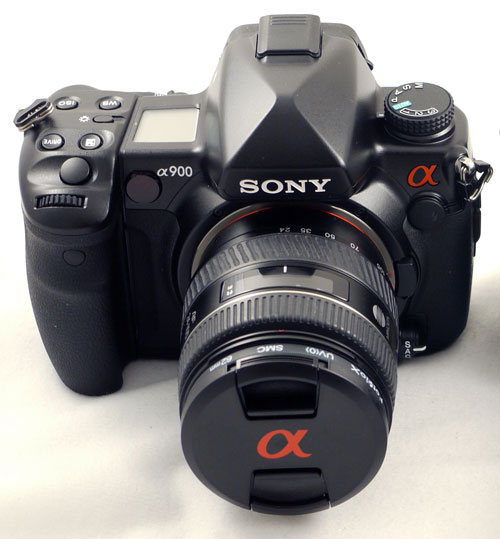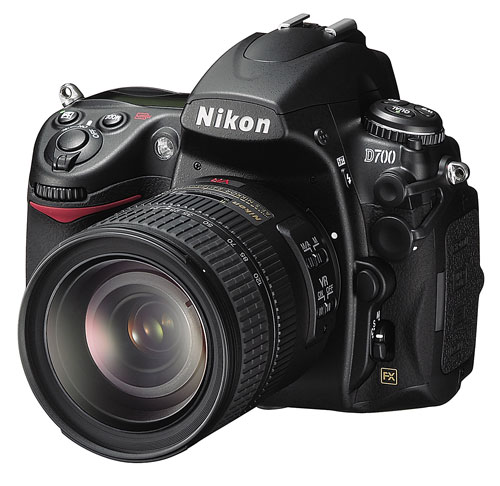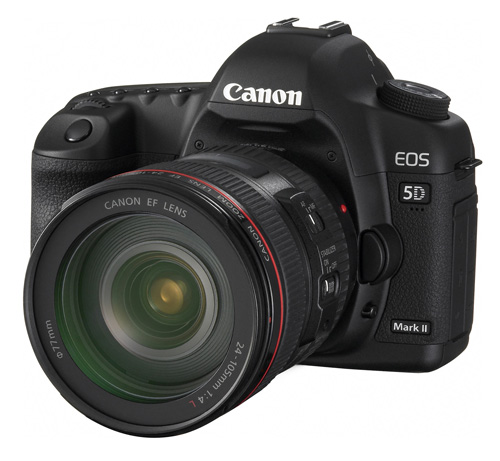Digital Cameras for the Holidays
by Wesley Fink on November 27, 2008 12:00 AM EST- Posted in
- Digital Camera
Full-Frame DSLRs
Just over a year ago we were predicting that the professional DSLR market would likely move completely to the full-size digital sensor. The speed with which this has actually happened is pretty impressive. A little over a year ago only Canon played alone in the full-frame arena, and their top selling full-frame pro model, the 1DS Mark II, was selling for $8000. Now just over a year later the top three camera manufacturers - Canon, Nikon, and Sony - all have full-frame offerings, and all of them have full-frame models that sell for $3000 or less.

Since acquiring Minolta, Sony has been aiming for more respect in the camera industry. A key part of that strategy was the launch of a full-frame Sony DSLR, which finally happened in the last couple of months. The new Sony A900 is not just another offering either, but a new full-frame solution. First, it features the highest resolution full-frame sensor you can buy with the 24.6MP Sony sensor. Pundits said Sony couldn't make a full-frame with Image Stabilization in the body, but that is exactly what they did. Steady Shot works great and makes any of the multitude of Sony and Minolta lenses that mount on the A900 image stabilized.
There is also the viewfinder. If anyone doubted Sony in the optics department they have only to look through the 100% view of the A900 viewfinder to be reminded again what optics and full-frame are all about. In fact, the Sony viewfinder is clearly the best, biggest, and brightest you will find in any current DSLR.
The A900 is not without its issues, however. 24.6MP is an incredible amount of detail, but noise starts to become a problem at ISO 1600. Everyone would like to see lower noise at the higher ISOs, but the detail captured at the highest ISOs, even with higher noise, is still very impressive. Sony has a huge lens lineup, mostly brought over direct form Minolta, but many of these designs could use a refresh. Also in terms of continuous speed, Sony, with all their mirror innovations like parallel link, still falls in the middle at 5 FPS between the super-high speed 9 FPS D3 and the new 3.5 FPS Canon 5D Mark II.

The Nikon D700 is the new cheaper Nikon full-frame designed to compete with the Sony A900 and the Canon 5D Mark II. When it launched just a few months ago it had no real peers, but now that the 24.6MP Sony A900 is shipping and the Canon 5D Mark II is 21.1MP, the Nikon line is starting to look like a new full-frame should be on the way. Nothing we have tested rivals the incredible low noise of the Nikon sensor, and D700 speed with the right battery is a blistering 8 FPS.

On paper, the Canon 5D Mark II looks like the one to beat in this category. After all Canon was first to offer a full-frame at the low price of around $3000 over three years ago, and Canon themselves proclaim the new 5D Mark II sensor the most advanced they make - better even than the $8000 1Ds Mark III. After the 50D failed to impress as completely as many expected of a 15.1MP Canon, most are waiting until the 5D Mark II production models start landing next week to decide how good they are.
The 5D Mark II updates everything to the very latest thinking in digital technology, including the two Live View modes, and a new twist that will likely be just the beginning of a revolution in the DSLR market. The Canon 5D Mark II also features a true 1080i HD movie mode that is pretty impressive in the early samples Canon has released. This true HD movie capability also auto-focuses. 21.1MP on a full-frame sensor means much bigger pixels than 15.1MP on a 1.6X crop sensor, so high hopes abound. Canon had the guts to include 25600 as an ISO speed option on the new 5D, matching the Nikon D3 and D700 in top ISO speed. If it is close to as good as the Nikon full-frames at high ISO it will not be long until you will see a Nikon D3x. You can be sure a Canon 1Ds Mark IV is also on its way early next year.
It is impossible to make a recommendation in the full-frame category because each camera in the group excels in different areas, and the decision will be based on your needs and the lens system you now use or choose. The Sony delivers the highest resolution any reviewer has ever tested, speed is good, and the viewfinder is the best. Ergonomics and ease-of-use are superb, but it is weak in high ISO noise at this point - which possibly will be much improved (as in the A700) with future firmware updates. The Nikons have the best High ISO performance and speed, but with half the resolution of the Sony A900. Still, for action or sports nothing comes close to the speed of the Nikon full-frames. The Canon 5D Mark II is the slowest of the group on continuous speed, but resolution may come close to the Sony and high ISO performance could be equal or near the Nikon full-frames.
We will soon have more answers to the question of which full-frame is "best", but the market niches that each of these three target will still likely make them three very different solutions for the full-frame market.










41 Comments
View All Comments
Flyboy27 - Friday, November 28, 2008 - link
Nikon D40. Seriously why would I need anything with more MP. Talk about fast and easy to use. Size and weight are very reasonable too. I can turn it on and take a picture before your p/s warms up.Flyboy27 - Friday, November 28, 2008 - link
I would like anandtech to have a serious discussion about magapixels. Why do higher megapixels matter? For web? no! The only way MPs matter is if your printing huge and by huge I mean greater than 20x30. How many times do you need prints that big anyways. Anyone that wants ultimate resolution is going to shoot film anyways. Film can be scanned by a professional lab at higher resolution than any DSLR can take. Just because you have a 20MP camera doesn't mean that you can resolve all those pixels anyways. My point? It is dumb to pay more for more megapixels. Any modern digital camera has enough MPs for any amateur and most pros.WTF is pro-sumer? = amateur photo geek with money. I doubt that pro photographers read this site for advice on cameras. They know what they want already.
All this said (if you want an upgrade from the D40) I think the D90 by Nikon would be a great camera if you want to go that route. It is not worth paying more for any other camera.
I bought a DSLR for the ability to learn to use an SLR camera without having to pay for film. I can learn from my mistakes instantly instead of waiting for film to be developed/scanned. If I already knew how to use an SLR and was comfortable I would be shooting 35mm film and getting it scanned at a much higher resolution than any digital camera.
Wesley Fink - Saturday, November 29, 2008 - link
If readers want to look a little deeper at sensor resolution, sensor size, and noise, take a look at our two part series on the Digital Sensor in The Digital Sensor: A Guide to Understanding Digital Cameras at http://www.anandtech.com/digitalcameras/showdoc.as...">http://www.anandtech.com/digitalcameras/showdoc.as... and The Digital Sensor: Part 2 at http://www.anandtech.com/digitalcameras/showdoc.as...">http://www.anandtech.com/digitalcameras/showdoc.as....Flyboy27 - Saturday, November 29, 2008 - link
Thanks Wesley,I wont go into Digital vs. Film. That is something that a person can only decide for himself. I've already gone into my reasons why I shoot digitally. Besides its all about getting great pictures right? It is my belief that you can get great pictures from most of the cameras out there. Some cameras just make it easier to take more great pictures.
Now my beef with resolution. Just as you have to sit close enough to a 1080p TV at a given size to tell the difference between it and a 720p set the same goes with digital photography. You have to ask yourself "What am I doing with these pictures that I'm going to be taking?" Am I going to make wall size prints? probably not. Am I going to make 20x30" prints? Maybe a few. Am I going to make 5x7s or 12x18s. Definitely. Am I going to use these photos on the web? Most Definitely. These are my answers and yours may be different but based on mine all I'll ever need is 6-10 mp. Fantastic, I don't have to pay extra for more mega pixels just because all the marketing says I do. Marketing tries it's hardest to make you go out an buy more than you need because they have to make money in order to make more cameras and stay in business.
I do take issue with Norman Koren's test. In the test he scanned the film with a $700 scanner. Big deal. He just wiped out any advantage that film might have. He's comparing a digital camera with a scanner, not film. Once again I'm not saying film or digital are better than one another. Pros use both.
I will check out Clark looks interesting and very technical.
I do love anandtech. Quality articles, objective testing. I've recently stopped reading another site due to the slow decline in the quality of their articles/publishing philosophy. Anandtech is now my main source for news and advice on computer hardware. Plus you actually respond intelligently to commentators and most of the commentators comment intelligently as well. Thanks guys.
Wesley Fink - Saturday, November 29, 2008 - link
Can you please provide the source for your information that film has higher resolution than any digital sensor? There are many experts who disagree with you.Norman Koren, the author of Imatest, which is a well-respected Resolution Test Suite, found the resolution of the top films to be equivalent to an 8.3 megapixel full-frame DSLR sensor at http://www.normankoren.com/Tutorials/MTF7.html">http://www.normankoren.com/Tutorials/MTF7.html. Clark at
http://www.clarkvision.com/imagedetail/film.vs.dig...">http://www.clarkvision.com/imagedetail/film.vs.dig... found that Fuji Velvia 100 and 50 were equivalent to a 10 megapixel sensor for intensity detail, and perhaps a 16 megapixel sensor for color detail. All other films he tested, including slide films, were lower in resolution. You can find charts for a wide variety of films at that link.
Clark's final conclusion was 10 to 16 megapixels were the equivalent range of the various film types. Since his work was mostly APS-C sensors it is not really at odds with Koran's tests.
Every other researcher who has tested has generally found 12 to 14 megapixels the equivalent of 35mm film. The larger resolution sensors do show any faults of your lenses and they require the very best glass to resolve those high resolutions.
We did discuss the relevance of megapixels in the article in the discussion of P&S cameras. Our recommendation was that cameras with these tiny sensors - 1/10 to 1/20 the size of an APS-C sensor - have reached the best balance of resolution and noise at around 7 to 9 megapixels. Anything more than this is a waste with these tiny sensors TODAY, but that could change with new sensor technology.
However, in the APS-C sensor the resolution trade-off probably is somewhere around 20 to 25 megapixels with current technology and somewhere around 40 to 50 megapixels in full-frame. Since the sensor is an Analog device that gathers light and converts it to digital info the physical size of the pixel is the most important specification for judging ISO range and noise.
Prosumer is a designation used by almost every camera review site. It is the same as Advanced Amateur. It basically means a class of cameras geared to the hobbyist or advanced amateur that is also used by some Pros. The lines have become particularly blurred as sealing has improved in this class and technical advances have accelerated in digital imaging.
computerfarmer - Friday, November 28, 2008 - link
Nikon D40 is a good camera with 6mp. Then there is the Nikon D40x with 10mp. Both have 23.7 x 15.6 mm CCD sensors. The D40x has ISO 100 and the D40 does not, it starts at ISO 200. The D60 has very little on the D40x and in some cases the D40x is better.You are correct in the fact the D40 will do the job and very well at that.
Nehemoth - Friday, November 28, 2008 - link
I would like to get one new camera bellow the 200US mark, but I don't like the cannon design and I would like that only use 2 AA batteries (so some fujifilm are out), also I like the aesthetics of those old cameras, like DSLR design.Any recomendation?.
computerfarmer - Friday, November 28, 2008 - link
The FujiFilm FinePix S700 has the DSLR look and is selling for 179CDN. It uses 4 AA batteries and has a 10x zoom. you can read user comments herehttp://www.dpreview.com/reviews/read_opinions.asp?...">http://www.dpreview.com/reviews/read_opinions.asp?...
Good luck
Nehemoth - Friday, November 28, 2008 - link
That's what I said before, I don't want fujitsu cause use 4 batteries, I would like of just 2 batteries.ubiloo - Friday, November 28, 2008 - link
I've been shooting since more than 20 years, I've used a lot of cameras from Canon, Nikon and Pentax.Even though the Pentax lacks a full-frame camera (shame! shame!), I'm deeply convinced of the fact that some current models really are among the best for the price. Why is Pentax so often absent from parades?
In particular, I think that the K200D is terrifying for its street price (I don't know about the K-m); I've now been using it for some time and it's a real solid camera with good, sometimes very good, picture quality. I bought it for at least €100 than any comparable camera. This particular model also deletes one of the drawbacks of previous models: with its kit lens, the auto-focus speed is really convincing, try to believe!
As for lenses, both Sigma and Tamron are available, so whenever Pentax is weak, they deliver...